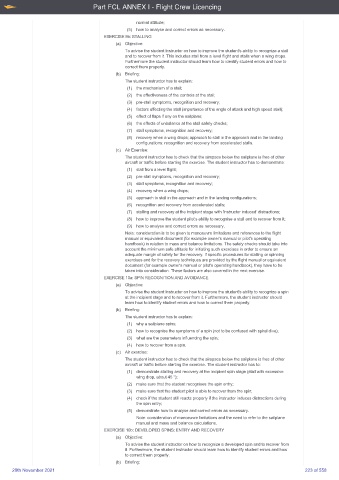Page 223 - UK Aircrew Regulations (Consolidated) 201121
P. 223
Part FCL ANNEX I - Flight Crew Licencing
normal attitude;
(5) how to analyse and correct errors as necessary.
EXERCISE 9b: STALLING
(a) Objective:
To advise the student Instructor on how to improve the student's ability to recognize a stall
and to recover from it. This includes stall from a level flight and stalls when a wing drops.
Furthermore the student instructor should learn how to identify student errors and how to
correct them properly.
(b) Briefing:
The student instructor has to explain:
(1) the mechanism of a stall;
(2) the effectiveness of the controls at the stall;
(3) pre-stall symptoms, recognition and recovery;
(4) factors affecting the stall (importance of the angle of attack and high speed stall);
(5) effect of flaps if any on the sailplane;
(6) the effects of unbalance at the stall safety checks;
(7) stall symptoms, recognition and recovery;
(8) recovery when a wing drops; approach to stall in the approach and in the landing
configurations: recognition and recovery from accelerated stalls.
(c) Air Exercise:
The student instructor has to check that the airspace below the sailplane is free of other
aircraft or traffic before starting the exercise. The student instructor has to demonstrate:
(1) stall from a level flight;
(2) pre-stall symptoms, recognition and recovery;
(3) stall symptoms, recognition and recovery;
(4) recovery when a wing drops;
(5) approach to stall in the approach and in the landing configurations;
(6) recognition and recovery from accelerated stalls;
(7) stalling and recovery at the incipient stage with 'instructor induced' distractions;
(8) how to improve the student pilot's ability to recognise a stall and to recover from it;
(9) how to analyse and correct errors as necessary.
Note: consideration is to be given to manoeuvre limitations and references to the flight
manual or equivalent document (for example owner's manual or pilot's operating
handbook) in relation to mass and balance limitations. The safety checks should take into
account the minimum safe altitude for initiating such exercises in order to ensure an
adequate margin of safety for the recovery. If specific procedures for stalling or spinning
exercises and for the recovery techniques are provided by the flight manual or equivalent
document (for example owner's manual or pilot's operating handbook), they have to be
taken into consideration. These factors are also covered in the next exercise.
EXERCISE 10a: SPIN RECOGNITION AND AVOIDANCE
(a) Objective:
To advise the student Instructor on how to improve the student's ability to recognize a spin
at the incipient stage and to recover from it. Furthermore, the student instructor should
learn how to identify student errors and how to correct them properly.
(b) Briefing:
The student instructor has to explain:
(1) why a sailplane spins;
(2) how to recognise the symptoms of a spin (not to be confused with spiral dive);
(3) what are the parameters influencing the spin;
(4) how to recover from a spin.
(c) Air exercise:
The student instructor has to check that the airspace below the sailplane is free of other
aircraft or traffic before starting the exercise. The student instructor has to:
(1) demonstrate stalling and recovery at the incipient spin stage (stall with excessive
wing drop, about 45 °);
(2) make sure that the student recognises the spin entry;
(3) make sure that the student pilot is able to recover from the spin;
(4) check if the student still reacts properly if the instructor induces distractions during
the spin entry;
(5) demonstrate how to analyse and correct errors as necessary.
Note: consideration of manoeuvre limitations and the need to refer to the sailplane
manual and mass and balance calculations.
EXERCISE 10b: DEVELOPED SPINS: ENTRY AND RECOVERY
(a) Objective:
To advise the student instructor on how to recognize a developed spin and to recover from
it. Furthermore, the student instructor should learn how to identify student errors and how
to correct them properly.
(b) Briefing:
20th November 2021 223 of 558

